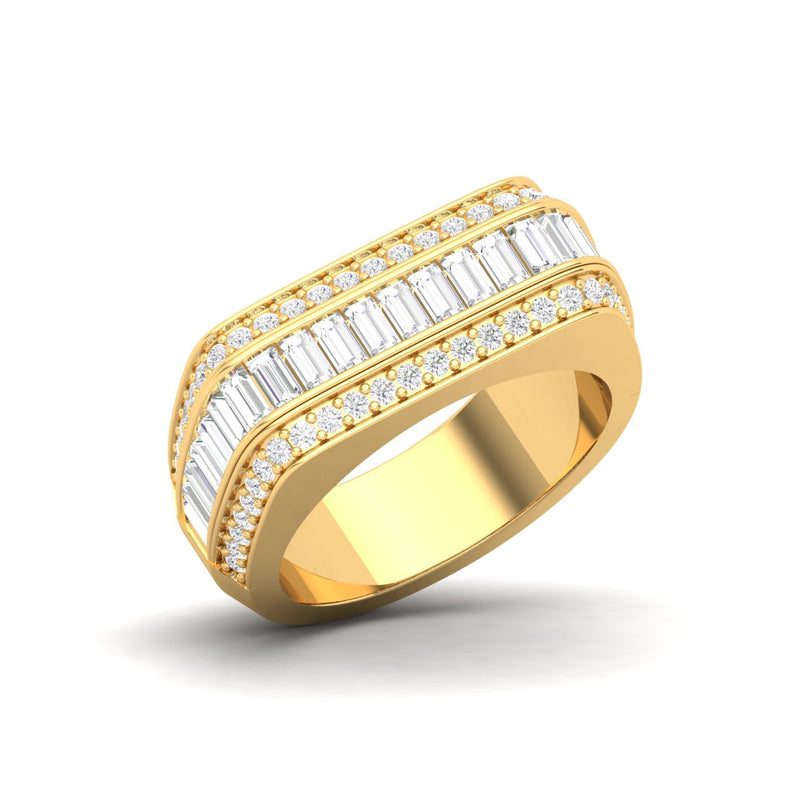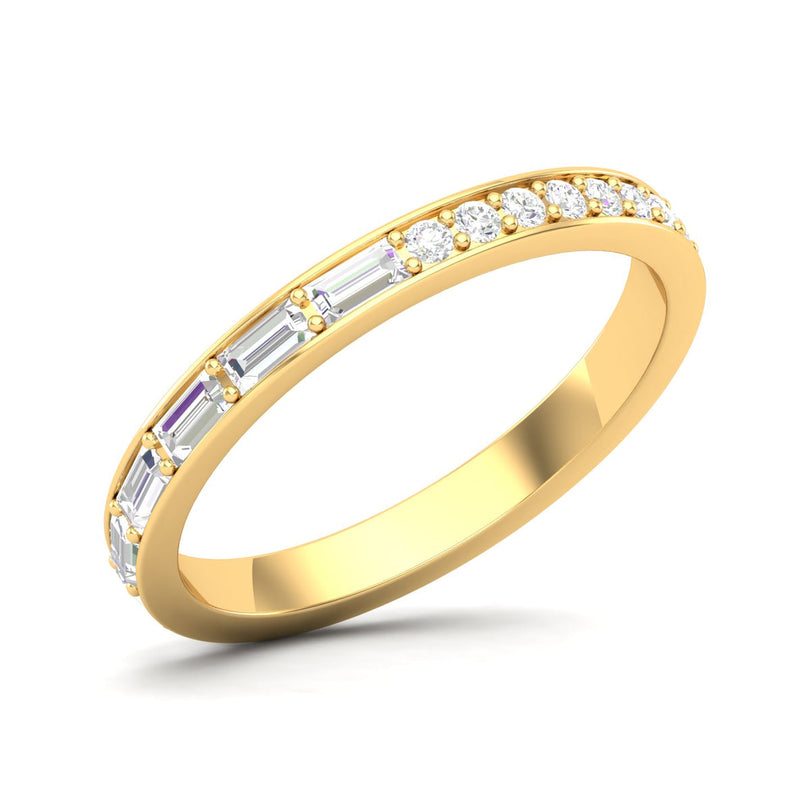Throughout the diamond trade, ethical purchasing as well as accountable practices have received more attention in recent years. By making this change, the mining and trading of diamonds will be done in a way that is both socially and ecologically sustainable. Diamonds are known for their unmatched brightness, which is among their most remarkable features. A beautiful display of shimmering and sparkle is produced by their crystal-clear nature, which allows light to travel through easily. All who see a diamond's mesmerizing beauty are enchanted by the rainbow dance that is produced by the interaction of light and diamonds within the stone. Diamonds are in a class of their own because of their capacity to refract and reflect sunlight. The world's hardest naturally existing substance, according to human knowledge, is a diamond, which is recognised for its extraordinary hardness. Diamonds have the rare quality of being scratch-resistant and having enduring toughness that stands through the ravages of time. The diamond's tenacity represents tenacity and serves as an illustration of the power residing inside each of us.
Overview
A diamond has been a compelling representation of flawlessness and elegance for a very long time because of its unmatched brightness. Diamonds reflect the transforming elements of April's emerging nature, just as daybreak bathes the globe in ethereal light. The diamond represents clarity and rebirth and captures the spirit of spring with its magnificent glitter.
The diamond's flawless beauty is an evidence to its unadulterated essence and reflects the ideals that people born in April try to uphold. Diamonds stand for the spotless purity of the spirit, much like the immaculate petals of a blooming flower. These stones act as an ongoing encouragement to treasure the purity and simplicity within in the midst of life's turmoil.
Diamonds are created under intense force in nature's laboratory from the Earth's core. This amazing adventure typifies the unbreakable character of April babies. In the same way that diamonds can endure tremendous pressure, people born in the month of April stand out for their tenacity and perseverance. Diamonds transform into a potent talisman and a symbol of courage that travels with April's travelers through the difficulties of life.

Symbolism
Beyond their breathtaking beauty and unquestionable rarity, diamonds, known as the "king of gemstones," have a rich symbolic meaning. These beautiful diamonds have been prized throughout centuries for their everlasting properties and significant meaning. We explore into the alluring symbolism of diamonds, investigating the various levels of significance they hold and the notions they stand for on a universal scale.
Since ancient times, integrity and brilliance have been linked to the diamond's crystal-clear beauty. Its flawless transparency serves as a representation of credibility, youth, and honesty, reflecting the ideals of the human soul. Diamonds inspire us to pursue ethical uprightness in a world that is frequently tainted by ambiguity and duplicity, as well as to embrace the core of our own innocence.
The idea of enduring love and loyalty is perhaps the most well-known emblem connected to diamonds. The tangible representation of an unbreakable link is made when a diamond is set in a wedding band or other piece of jewelry. Passion, like the diamond itself, is eternal because it is unbreakable and ageless, and the diamond's endurance and eternal quality serve as a monument to this.
Properties
Hardness and strength
Diamonds have an unparalleled amount of toughness because they were created under extreme conditions of pressure and heat below under the Earth's mantle. The most durable naturally existing substance known to mankind is a diamond, which receives a perfect 10 on the Mohs scale, a commonly used indicator of mineral hardness. The closely bound atoms of carbon that make up a diamond's crystal lattice framework create a solid, tightly organized configuration that resists distortion, which accounts for the stone's exceptional hardness.
Treatment
- The diamond manufacturing sector uses enhancements to the gemstone's appearance in its pursuit of excellence. These processes work to enhance the diamond's inherent qualities by enhancing its clarity, color, and overall appearance.
- Clarity augmentation is one of the processes most frequently used on diamonds. The inclusions and intrinsic imperfections inside the diamond are reduced to a minimum or removed using procedures like laser drilling and crack filling.
- As opposed to fracture filling, which plugs interior fissures with materials that increase clarity, laser drilling includes employing laser beams to eliminate apparent impurities.
- The natural color of diamonds can be changed using color enhancement techniques. These processes can turn less desirable diamonds into vibrantly coloured jewels, giving customers more choices.
- Diamonds are treated to high altitudes and flames during HPHT treatment in order to change their color and clarity. This process can alter the diamond's internal structure or remove some impurities, enhancing the diamond's color or improving its clarity.
Quality and grading
Color
Yellow and Brown Diamonds:
Yellow and brown diamonds are the most common fancy colors. Ranging from pale champagne to deep cognac, these diamonds owe their color to the presence of nitrogen within their crystal structure.
Blue Diamonds:
Blue diamonds are among the rarest and most coveted of fancy colors. Their captivating blue hues are caused by the presence of boron impurities within the diamond's atomic structure.
Pink and Red Diamonds:
Pink and red diamonds are the epitome of rarity and luxury. Their breathtaking hues are a result of a distortion in the diamond's crystal lattice structure.
Green, Orange, and Other Fancy Colors:
Green and orange diamonds are relatively uncommon and derive their colors from radiation exposure or structural anomalies. The hues range from subtle olive greens or citrusy oranges to vivid and vibrant shades that captivate the eye.
Clarity
The internationally recognised diamond clarity grading system, which ranges from Flawless (FL) to Included (I3), was developed by the Gemological Institute of America (GIA). On this scale, flaws and inclusions are rated according to how noticeable they are and how they affect a diamond's overall beauty. A diamond's brilliance may be evaluated by customers and experts according to the scale's grades, which each denote a different level of clarity.
Cut
The 4Cs and Cut:The Gemological Institute of America (GIA) established the 4Cs grading system to evaluate diamonds, with cut being one of the four critical factors alongside color, clarity, and carat weight.
Round Brilliant Cut:
Designed to maximize light performance, it features 58 facets that create an exceptional display of brilliance, fire, and scintillation.
Fancy Shape Cuts:
Fancy shape cuts encompass a variety of non-round diamond shapes, each with its own unique charm. These cuts include the princess, emerald, cushion, pear, marquise, oval, radiant, and heart shapes.
Princess Cut:
The princess cut is a popular fancy shape cut known for its square or rectangular shape with pointed corners.
Emerald Cut:
The emerald cut features a rectangular shape with beveled corners and a step-cut faceting style.
Carat
A diamond's mass is measured in terms of carat weight, with a single carat equaling 200 milligrammes or 0.2 grammes. The word "carat" comes from the cacao seed, whose uniform weight has historically been used to balance scales. The value of a diamond is frequently thought to be primarily determined by its carat weight, with bigger diamonds typically fetching greater prices.
Care instructions
- Cleaning on a regular basis is necessary for maintaining your diamonds appearing their best. Diamond jewelry may be cleaned at home with some hot water and gentle dish soap.
- Substances can harm diamond sets and reduce their brilliance. It is essential to keep your diamonds away from common household chemicals like cleaning supplies, sprays for hair, and cologne.
- To avoid chipping or impairment, keep your diamond jewelry in a soft case or a separate container when not in use.
- For keeping your diamonds in their best state, arrange periodic examinations with a reputable jeweler who can expertly clean, inspect, and make any needed adjustments.
- It is crucial to frequently check the prongs on jewelry with prong settings, such as diamond rings. Prongs might deteriorate or come loosened over time, endangering the integrity of the diamond.
- Even though they are highly resilient, diamonds can nevertheless chip or flake when subjected to high pressure or friction.
- To have your priceless diamonds professionally polished at suggested intervals, consult with a trustworthy jeweler who specializes in diamond maintenance.







